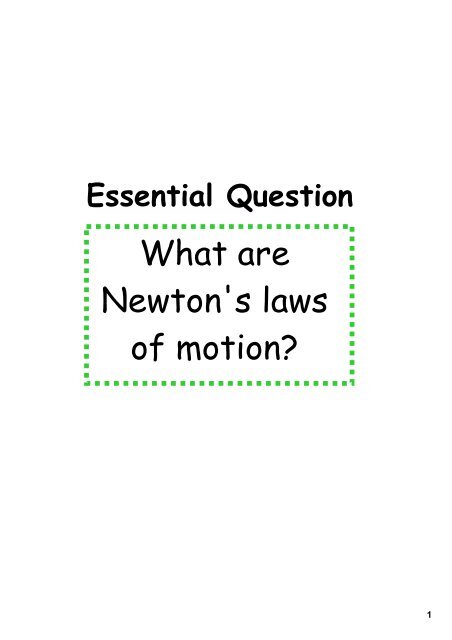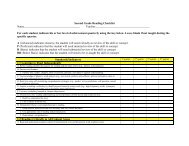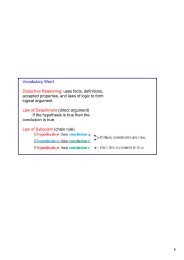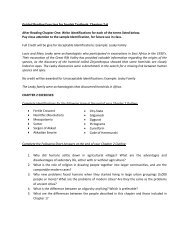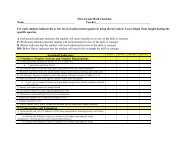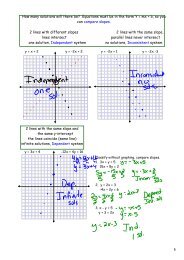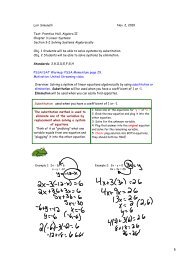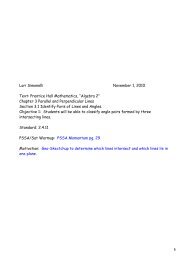What are Newton's laws of motion?
What are Newton's laws of motion?
What are Newton's laws of motion?
Create successful ePaper yourself
Turn your PDF publications into a flip-book with our unique Google optimized e-Paper software.
Essential Question<br />
<strong>What</strong> <strong>are</strong><br />
<strong>Newton's</strong> <strong>laws</strong><br />
<strong>of</strong> <strong>motion</strong><br />
1
Notes November 14, 2011<br />
Essential Question: <strong>What</strong> <strong>are</strong> <strong>Newton's</strong> <strong>laws</strong> <strong>of</strong> <strong>motion</strong><br />
Sir Isaac Newton<br />
<strong>Newton's</strong> First Law <strong>of</strong> Motion<br />
States that an object in <strong>motion</strong> will remain in <strong>motion</strong> and an object at<br />
rest will stay at rest... unless, some outside force (an unbalanced<br />
force) acts on the object causing it to keep moving or stop.<br />
AKA: The Law <strong>of</strong> Inertia<br />
Inertia is an object's tendency to resist a<br />
change in <strong>motion</strong>.<br />
<strong>What</strong> does that really mean<br />
Think <strong>of</strong> a car crash - the car may stop, but what happens to you ...<br />
You (and everything else in your car) keep moving.<br />
2
<strong>Newton's</strong> Second Law <strong>of</strong> Motion<br />
States that an object's acceleration (its change<br />
in speed) depends on the object's mass and the<br />
force applied to the object.<br />
Easy<br />
Difficult<br />
Which hurts more... (which applies more FORCE)<br />
An elephant (5000 g) running into you at 2 meters per second<br />
OR<br />
A mouse (800 g) running into you at 50 meters per second<br />
3
Formula<br />
<strong>Newton's</strong> Second Law<br />
F<br />
Cover what you need<br />
to solve for<br />
M<br />
A<br />
UNITS<br />
F = NEWTONS (N)<br />
M = KG<br />
A = M/S 2<br />
4
The Law <strong>of</strong> Universal Gravitation<br />
The force <strong>of</strong> attraction between two<br />
objects that results from their<br />
masses and the distance between the<br />
two objects. All objects <strong>are</strong> attracted<br />
to one another.<br />
Gravitational Force = gravity constant X (mass1 X mass2)<br />
distance<br />
plug in here<br />
Gravity Constant = 6.67 x 10 -11<br />
Calculate the force <strong>of</strong> gravity between a 3.0 kg newborn baby<br />
and a 75 kg doctor standing 0.25 m away from each other.<br />
6
<strong>What</strong> is the force <strong>of</strong> gravity between an<br />
apple with a mass <strong>of</strong>.25 kg and a<br />
pumpkin with a mass <strong>of</strong> 4 kgs if they <strong>are</strong><br />
5 meters apart<br />
Formula = G mass 1 mass 2<br />
distance<br />
<strong>What</strong> does G =<br />
G= 6.67 x 10 -11<br />
Force<br />
<strong>of</strong><br />
Gravity<br />
= 6.67 x 10 -11 .25 kg 4 kg<br />
5 meters<br />
P<strong>are</strong>nthesis<br />
First!<br />
.25 kg x 4 kg<br />
5 meters<br />
1 kg<br />
5 m<br />
= .2<br />
Multiply that by your<br />
given gravity constant!<br />
6.67 x10 -11 .2<br />
7
Newtons third law <strong>of</strong> <strong>motion</strong><br />
states that for every action<br />
there is an equal and opposite<br />
reaction.<br />
AKA - Law <strong>of</strong> Momentum<br />
<strong>What</strong> is Momentum<br />
Momentum: the property <strong>of</strong> a<br />
moving object that equals its mass<br />
times its velocity.<br />
Which has more momentum<br />
OR<br />
Running 50 km/hr<br />
Running 50 km/hr<br />
8
OUTSIDE<br />
<strong>Newton's</strong> Law Foldable<br />
<strong>Newton's</strong><br />
1st<br />
Law<br />
<strong>Newton's</strong><br />
2nd<br />
Law<br />
Universal<br />
Law<br />
<strong>of</strong><br />
Gravitation<br />
<strong>Newton's</strong><br />
3rd<br />
Law<br />
INSIDE<br />
Description<br />
Description<br />
Description<br />
Description<br />
Formula<br />
Formula<br />
Everyday Example<br />
Everyday Example<br />
Everyday Example<br />
Everyday Example<br />
9
Formula:<br />
Momentum (p) = mass (kg) x velocity (m/s)<br />
p= mv<br />
Unit for momentum is kg m/s<br />
At the end <strong>of</strong> a race, a sprinter with a mass <strong>of</strong> 80 kg has a speed <strong>of</strong><br />
10 m/s. <strong>What</strong> is the sprinter's momentum<br />
10


